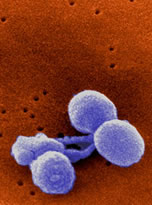Read and report vaccine reactions, harassment and failures.

S. pneumoniae, the bacteria which causes pneumococcal disease, is contagious and is spread through coughing, sneezing or direct contact with respiratory secretions. The exact period of communicability of pneumococcal disease is not known, however, it is generally believed that as long as the strain remains present in the respiratory secretions, it has the capacity to be transmitted to others. One study suggests that S. pneumoniae bacteria may exist on the surfaces of commonly handled objects for some time (minutes to no more than three days), raising the possibility of direct infection.
Pneumococcal infections are more common during the winter and in early spring when respiratory diseases are more prevalent. Outbreaks of pneumococcal disease are not common, but the risk of an outbreak is increased in environments where a lot of people are enclosed in crowded spaces. Environments where pneumococcal disease is more likely to spread include nursing homes, residential housing facilities, orphanages, and daycare centers.
People, especially children, often have pneumococcal bacteria present in their nose or throat at some time or another without any clinical illness. This is referred to as “carriage.” It is still not known why carriage only rarely leads to clinical illness.
Infection, however, occurs most often after acquiring a new pneumococcal strain, and studies have shown that 15 percent of children who acquire a new strain become ill with acute otitis media or another type of pneumococcal disease within one month of acquiring the strain.
IMPORTANT NOTE: NVIC encourages you to become fully informed about Pneumococcal and the Pneumococcal vaccine by reading all sections in the Table of Contents , which contain many links and resources such as the manufacturer product information inserts, and to speak with one or more trusted health care professionals before making a vaccination decision for yourself or your child. This information is for educational purposes only and is not intended as medical advice.



